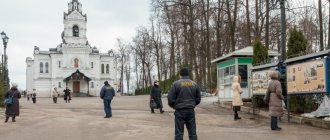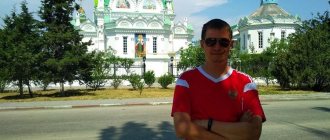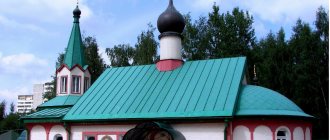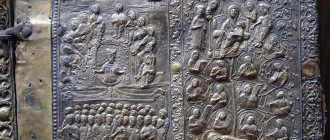Business ideas
Now even in Antarctica you can find churches and temples. Brave explorers of the icy continent also need support from above, perhaps even more than others. This review presents the southernmost places of worship on Earth.
Church of the Snows
Non-denominational Christian chapel, one of the southernmost churches in the world. Belongs to the American Antarctic station McMurdo, located on Ross Island. Despite its location, it was destroyed by fire twice.
In winter, the church is attended by 200 parishioners, and in summer, the parish grows to 1000 people.
The Church of the Snows tries to meet the needs of adherents of any religion. The Rev. Michael Smith even performed Buddhist and Bahai ceremonies.
Holy Trinity Church
There is also an Orthodox church in Antarctica - the Russian Orthodox Church on Waterloo Island not far from the Russian polar station Bellingshausen. The temple was built in Russia, stayed there for a year, and then was dismantled and transported to Antarctica. The temple was reassembled on site in 2 months.
The temple can accommodate up to 30 people at a time; a wedding ceremony was even held here. The abbot of the temple changes every year, along with other researchers.
Catholic chapel in the ice cave at Belgrano II station
The southernmost church in the world is located in an ice cave in the Argentine polar region of Belgrano II. Day and night here alternate at intervals of 4 months, and the southern aurora can be seen in the night sky.
Church of Saint Francis of Assisi
The Esperanza research station, where the Church of St. Francis is located, is considered by Argentines to be their southernmost city, although it does not amount to more than a small village. It is one of thirteen Argentine settlements on the continent.
In addition to the church, there is also a permanent school, a museum, a bar and a hospital with a maternity ward, where several Argentines were born.
Chapel of St. Ivan Rylsky on Livingston Island
An Orthodox church built at the Bulgarian polar station, founded by four explorers in 1988.
Despite the asceticism, there is even a real bell, donated by the former Deputy Prime Minister of Bulgaria, who once worked at the station as a doctor.
Chilean Chapel of Santa Maria Reina de la Paz
This may be the only church in the world built from shipping containers. Located in the largest civilian settlement in Antarctica, Villa las Estrellas. Families of workers from the Chilean military base, to which the settlement belongs, live here year-round. Up to 80 people stay here for the winter, and 120 in the summer. There is also a school, a hostel, a post office and a bank in the village.
Chapel of the Blessed Virgin of Lujan
The chapel is located at another Argentine Antarctic station, Marambio. At the time of construction, this was the first airfield in Antarctica, and it is still used very often. Thanks to this, the station is called the “gateway to Antarctica.”
Another church that deserves attention, but it is not located in Antarctica itself, but nearby, beyond the Antarctic Circle.
Whalers Church
This Norwegian Lutheran church was built in the whaling village of Grytviken, South Georgia in 1913.
The church was built by the sailors themselves, and this is the only building in the village that is used for its original purpose. The whaling station itself was abandoned in 1966.
The southernmost Orthodox church in our country is the Church of the Holy Trinity, which is located on the Island of Waterloo, part of the South Shetland Islands. It is located in Antarctica, next to the Russian polar station Bellingshausen. It is small - its height is 15 meters and can accommodate about thirty people. Currently, this temple is the Patriarchal Metochion.
The idea to build a temple on the territory of Antarctica originated in the 1990s with the head of the Russian Antarctic expedition Valery Lukin, the captain of the Metelitsa women's team Valentina Kuznetsova and His Holiness Patriarch Alexy II. The idea of creating this temple was actively supported by Peter Zadirov, the head of the Antarctic airline. To implement this idea, a special fund “Temple of Antarctica” was created, which received the blessing of Patriarch Alexy II. The Foundation organized an all-Russian competition, in which the project of Barnaul masters P.I. Anisifov and S.G. Rybak won. and Shmidt A.B.
In January 2002, the location of the future temple was consecrated. After this, the painstaking work of building the temple began.
The creation of the temple was undertaken by a team of Gorno-Altai carpenters, under the leadership of K.V. Khromov. The temple was created in Altai in the village of Kyzyl-Ozek. To create it, they used cedar and larch wood that grew on the shores of Lake Teletskoye. After the construction of the temple, it was allowed to “settle” for a year, and then it was dismantled and transported in parts to Kaliningrad, and from there on the ship “Akademik Sergei Vavilov” to Antarctica. Already on the site, the temple was reassembled by a team of eight people over the course of 60 days. The iconostasis of the temple is decorated with icons made by Dmitrov icon painters, led by Valery Grishanov. A residential house was built next to the temple to house the clergy.
On February 15, 2004, the abbot of the Holy Trinity Sergius Lavra, Bishop Feognost of Sergiev Posad, in the presence of numerous representatives of the clergy, sponsors and pilgrims, consecrated the temple in the name of the Holy Trinity.
The first rector of the temple was the 30-year-old hieromonk Kallistratt (Romanenko), who in the past was the head of the monastery on the island of Anzar, part of the Solovetsky archipelago. He spent more than a year at the Antarctic temple. In March 2005, he was replaced by two other hieromonks, Father Vladimir (Petrakov) and Father Gabriel (Bogachikhin). For a year they held sacred services in this church.
Since then, the Lavra hieromonks have replaced each other every year. Their shift schedule was the same as that of workers at Antarctic research stations. Despite the difficult living conditions, many of the monks visited here more than once. So in 2006, Father Kallistrat was again the Antarctic clergyman, and in 2007 Father Vladimir was again, but with another monk, Father Sergius (Yurin).
Over time, the church receives a permanent priest - Father George, a polar explorer with twenty years of experience.
Funding for this project was provided by Petr Zadirov, a former polar explorer and parachutist. Its aircraft, since 1990, have been providing cargo delivery to polar stations.
For some time, the Church of the Holy Trinity was considered the southernmost Orthodox church in the world. Currently, at the Bulgarian scientific station, "St. Kliment Ohridski", located on the island of Smolensk, there is a chapel of St. John of Rila, which is located slightly south of the Church of the Holy Trinity. Also south of the Church of the Holy Trinity at the Ukrainian station “Akademik Vernadsky” there is the chapel of St. Equal-to-the-Apostles Prince Vladimir.
It is important to note the fact that on January 29, 2007, in the Church of the Holy Trinity, the wedding of Russian citizen Angelina Zhuldybina and Chilean Eduardo Aliaga Ilabac, who worked at the Chilean Antarctic scientific station, took place.
Antarctica is an icy desert in which life seems to freeze. But even in this desolate and harsh place, people find the opportunity to take care of their souls. In our review, there are seven churches of various denominations that operate in Antarctica today, being the southernmost points of religious worship on the planet.
Church of the Snows
The history of the Temple of the Snows, located at the American research station on Ross Island, is very sad. Despite the fact that the temple, built in 1956, is located among ice and snow, it burned to the ground twice. The building first caught fire in 1978 due to problems with the heating system. The temple, rebuilt from scratch, burned down again after being abandoned for several years following a severe storm.
After the second fire, the temple was rebuilt again and decorated with stained glass windows depicting Antarctic landscapes. In winter, about 200 people work at the station, and in summer the number of visitors reaches 1000. Since the temple is non-denominational, followers of all religions can come here, and Father Michael Smith even conducted Buddhist and Bahai rituals.
What churches look like in Antarctica. Photo
The southernmost places of worship on the planet.
Antarctica is officially recognized as a desert and, accordingly, is the largest such area in the world. But explorers and scientists, fearlessly battling the harshest climatic conditions, still found time for religion even in the icy, barren landscape. There are at least seven operating churches in Antarctica, which are the southernmost places of worship on the planet, reports Chronicle.info with reference to Telegraph.
Church of the Snows
The fate of the church, which is located at the American research station on Ross Island, cannot be called happy. Despite the fact that it was built back in 1956 in the icy desert, it was destroyed by fire twice. The first building caught fire in 1978 from a spark in the heating room, and the next one burned down, standing abandoned for several years after a severe storm in May 1991.
The current church received colored stained glass windows with Antarctic views. In the winter season, about 200 people work at the station; in the summer, the number of guests sometimes reaches 1000 people. The non-denominational church welcomes visitors of different faiths, and the rector, Father Michael Smith, has even conducted Buddhist and Baha'i ceremonies.
Holy Trinity Church
This Orthodox church was built in Russia from Siberian pine and then transported by food ship to the Russian (former Soviet) Antarctic station Bellingshausen on Waterloo Island in 2004. Since two monks from Russia voluntarily spent a year in the church, the abbots here are replaced every year.
The 15 m high wooden temple, decorated with carvings, fearlessly withstands the polar winds. It simultaneously accommodates up to 30 people and satisfies the spiritual needs of employees of nearby stations: Russian, Chilean, Polish and Korean. Some services are held in Spanish. The priest also prays for the souls of the 64 dead Russian polar explorers. And although the church is rarely crowded, the wedding of Russian and Chilean explorers took place here, and baptismal ceremonies are sometimes held here.
Catholic church in a cave.
This ice-walled cave at the base of Belgrano II is the southernmost religious building in the world. The Catholic Church, open year-round, operates from an Argentine research base built in 1955 on Cotes Island. The geographical latitude determines that the days and nights here last for four months and the southern aurora is often visible in the dark sky.
Church of St. Francis of Assisi.
Esperanza, one of 13 Argentine research stations in Antarctica, is considered Argentina's southernmost city (though it's more of a village). In addition to the church, there is a school with teachers, a museum, a bar and a hospital with a maternity ward where several Argentines were born.
And while the researchers clearly want to be closer to God while working in Antarctica, they see no conflict in having a church coexist with a casino (which also doubles as a local community center).
Church of St. John of Rila.
The snow-covered church stands at the Bulgarian base of St. Kliment of Ohrid, founded in 1988 by four Bulgarians, on Livingston Island. Despite its modest appearance, the church has a bell, which was given to it by the former Deputy Prime Minister of Bulgaria. He worked at the base as a doctor in 1993–1994.
Chilean Church of St. Mary.
This is probably one of the few churches in the world made from shipping containers. This unusual religious building is located in the largest settlement in Antarctica, where 120 people live in summer and 80 in winter. Several military families with children live at Villa las Estrellas, a Chilean military base on the island of Waterloo. The maximum period of stay at the base is two years. The ceremonies are performed by a priest who lives on the island all year round. The town also has a school, a hostel, a post office and a bank.
Catholic Church of Our Lady of Lujan.
In the photo next to the metal frame of the church at another Argentine research base, Marambio, Father Nicolas Daniel Julián looks like he could use a warmer jacket. He helped build the church on a year-round base that is considered Argentina's most important on the continent. At the time of construction, there was the only airfield in Antarctica, and it still remains one of the most popular, as it is suitable for landing on chassis, for which it received the name “Gateway to Antarctica.”
Church of the Whalers: A subantarctic church.
This neo-Gothic temple was built in 1913 at the whaling station at Grytviken, a settlement in southern Georgia founded by a Norwegian captain. The church was built by the whalers themselves and is the only one still in use after the station closed in 1966.
The settlement appeared in 1904, and in the first year the residents managed to catch 195 whales. Whalers used all parts of the animal: fat, meat, bones and entrails. Fertilizers and feed were made from bones and meat, and oil was heated from fat. For the same reason, fishermen hunted elephant seals. During its heyday, the station employed about 300 people during the summer months from October to March.
Over the next 60 years, the number of whales in the waters around the island declined significantly and the station closed. By this time, there were so few whales left that further fishing became impractical. Even now, the shores around Grytviken are littered with whale skeletons, the remains of oil refineries and fishing boats.
Trinity Church
The Orthodox church building was built in Gorno-Altaisk in the 1990s from Siberian pine, and then it was transported on a supply ship to the Russian Antarctic station Bellingshausen, located on King George Island. Initially, two monks from a Russian monastery voluntarily spent a year in the Antarctic church, and since then the monastery annually sends priest-rectors to the Trinity Church.
Despite the destructive power of the polar winds, the 15-meter-high wooden carved structure has stood unshakable for more than 10 years. The church can accommodate up to 30 parishioners; employees of Russian, Chilean, Polish and Korean stations located in Antarctica come here to pray.
Stronghold of Orthodoxy in Antarctica
For more than two centuries, humanity has known the southernmost continent, covered with ice and a lot of snow. The “Ice Land” was discovered by the brave Russian pioneers Bellingshausen and Lazarev. Today this continent is studied by geologists, biologists and meteorologists from many countries, and each of them always rejoices at the sight of a religious structure flaunting on the territory of eternal snow.
Holy Trinity Church in Antarctica
This temple reaches a height of 15 meters and can accommodate up to 30 parishioners. It was built to meet the spiritual needs of nearby station workers. Here employees of Russian, Korean and Chilean organizations confess and ask for help. Some liturgies are celebrated in Spanish. People often pray here for the dead polar explorers.
The temple is rarely filled, however, ceremonial weddings of workers and baptismal ceremonies took place here.
Antarctica is the southernmost place on earth where a believer can find an Orthodox church. The gilded domes of the temple, created in the name of the Holy Trinity, demonstrate the power of Christian teaching, which has spread far beyond its usual places. Brave travelers passing through the southern outskirts of Chile soon observe the brilliance of this divine structure and are filled with faith in the power of the Creator.
Important! Researchers working on this continent stay here for long periods of time, so they carry with them all the traditions and celebrations of the larger society. This temple allows believers to celebrate Easter and other celebrations of the Orthodox tradition.
Church of Saint Francis of Assisi
Esperanza Station is one of thirteen Argentine research bases in Antarctica, and the Argentines themselves consider it the southernmost “city” (although it is more likely a village).
In addition to the temple, the research base has a permanent school with teachers, a museum, a bar and a hospital with a ward for women in labor.
Next to the church is a casino that also serves as a community center.
Chilean Church of Saint Mary
This is probably one of the few churches in the world made from shipping containers. This unusual religious building is located in the largest settlement in Antarctica, where 120 people live in summer and 80 in winter. Several military families with children live at Villa las Estrellas, a Chilean military base on the island of Waterloo. The maximum period of stay at the base is two years. The ceremonies are performed by a priest who lives on the island all year round. The town also has a school, a hostel, a post office and a bank.
Church of St. John of Rila
The temple, surrounded on all sides by a wall of solid snow, is located on the Bulgarian base of St. Clement of Ohrid, founded in 1988 by four Bulgarians.
Although the church looks rather modest, it has a chapel with a bell donated by the former Deputy Prime Minister of Bulgaria, who worked as a doctor at the Bulgarian base in 1993-1994.
Catholic Church of the Virgin Mary
Pictured standing next to a metal Catholic church at an Argentine research base, Father Nicholas Daniel Julián looks like he could use some warmer clothes.
Father Julián helped build a permanent church at the Marambio base, which is considered Argentina's most important and equipped base on the continent.
It is worth noting that Antakrtida is not the only place where people build temples. For example, . The chapel rises 280 feet above the city, and 268 stone steps lead to its entrance.
Now even in Antarctica you can find churches and temples. Brave explorers of the icy continent also need support from above, perhaps even more than others. This review presents the southernmost places of worship on Earth.
Church of the Snows
Non-denominational Christian chapel, one of the southernmost churches in the world.
Belongs to the American Antarctic station McMurdo, located on Ross Island. Despite its location, it was destroyed by fire twice. In winter, the church is attended by 200 parishioners, and in summer, the parish grows to 1000 people.
The Church of the Snows tries to meet the needs of adherents of any religion. The Rev. Michael Smith even performed Buddhist and Bahai ceremonies.
Whalers Church
This Norwegian Lutheran church was built in the whaling village of Grytviken, South Georgia in 1913.
The church was built by the sailors themselves, and this is the only building in the village that is used for its original purpose. The whaling station itself was abandoned in 1966.
During the “heyday” of the station, up to 300 people lived and worked here at the same time. Abandoned cinema:
The whale population around South Georgia declined steadily until the station was closed. To this day, in the vicinity of the village you can find animal bones, rusted remains of ships and factories for processing whale oil.
The distant and mysterious continent of Antarctica, shrouded in centuries-old ice that hides the secrets of the birth of the planet as we know it now and as it was at the beginning of time. The land of eternal snow, inexorable frosts, strong winds and, oddly enough, people seeking truth in the extreme conditions of existence of human bodies, and only an indefatigable spirit and thirst for adventure and knowledge, which opens its doors bit by bit, are able to withstand all sent by the hostile continent tests in order to later proudly call it home.
Golden domes of the Russian Church of the Holy Trinity in Antarctica
Oddly enough, Antarctica is the last place on earth where you can see an Orthodox Russian church, but the first thing that intrepid travelers see when crossing from Chile to the ice-shrouded continent is the gilded domes of the Church of the Holy Trinity
, as a ray of hope and support for the Orthodox faith at the ends of the earth.
It’s been almost two hundred years since the discovery of the “ice land” by Russian daredevils Bellingshausen and Lazarev
, Researchers from all over the world are trying to study and harness Antarctica:
- geologists;
- biologists;
- chemists;
- meteorologists.
Everyone considers it their duty, as a servant of science, to take a first-hand look at the incredible creation of Mother Earth at least once in their life.
Researchers have to stay in Antarctica for six months and naturally they bring with them all the customs and holidays of the civilized world, and what Russian, even a scientist, can, say, on Easter, do without the Orthodox Church, which warms exhausted souls so warmly, like a home? . And so in two thousand and two on the island of Waterloo
Russian polar explorers built the Russian Orthodox Church of the Holy Trinity.
The history of the creation of the Holy Trinity Church in Antarctica
Initially, the idea of creating the Russian Church of the Holy Trinity in Antarctica was born back in the nineties of the last century and it belonged to the Russian traveler and head of the polar expedition Valery Lukin
.
This is not a simple, but noble enterprise, approved by Patriarch Alexy II
, who subsequently created a special fund to raise funds for the construction. And only twelve years later, in two thousand and two, the project to create a church in Antarctica began to develop rapidly. The land, previously prepared for the church, was consecrated, and work began on its construction.
But construction took place not in Antarctica, but in Altai in the village of Kyzyl-Ozek
.
The construction was carried out by the best carpenters in Gorno-Altaisk under the leadership of Khromov. The best varieties of larch and cedar from the shores of Lake Teletskoye were selected for the church. Having completed construction, the structure stood for another year in Altai, after which all the logs were numbered for reference and, disassembled, went to distant Antarctica on the ship “Akademik Sergei Vavilov”
.
On site, a special team of eight carpenters assembled it in just two months. And on February fifteenth, two thousand and four,
Russian polar explorers celebrated a long-awaited event -
the consecration of the temple
.
The consecration of the church was conducted by Bishop Feognost of Sergiev Posad, vicar of the Holy Trotsky Sergius Lavra
. Among those present were many pilgrims, representatives of the clergy, as well as sponsors. Among the many proposals for consecration, the clergy settled on sprinkling the church in honor of the Holy Trinity, although it was originally planned to dedicate it to the Saint, the patron saint of maritime affairs and travelers.
At first, the Church of the Holy Trinity in Antarctica repeatedly changed clergy:
- The first was the thirty-year-old monk Callistratus
, who distinguished himself by serving on the island of Anzar as the head of the monasteries. - A little more than a year later, he was replaced by two clergymen, Fathers Vladimir and Gabriel,
who, like polar explorers, conducted their services in shifts. - A year later, in two thousand and six, Father Kallistratus came to replace them again, and a year later Father Vladimir arrived again, but with Father Sergius
. - After some time, they are replaced by an already experienced polar explorer with twenty years of experience behind him, Father George
, who conducts services in the Church of the Holy Trinity to this day.
The life of priests in Antarctica differs in many ways from ordinary everyday life in the temple of the civilized world. Together with former polar explorers, they pick up axes and saws, make their way through the walls of snow and stand honorably on watch. At the end of the earth, everyone will find this, the last place where they can exist carefree, enjoying the monotonous everyday life.
Geographical location
One time before the construction of temples in Antarctica, or rather, the chapel of St. Prince Vladimir
at the Ukrainian station and the Bulgarian
chapel of John of Rylsky
, the Church of the Holy Trinity was the southernmost stronghold of Orthodox Christians and, probably, the temple whose location is the most unfavorable in the world in terms of climatic conditions. To make the structure only fifteen meters strong, it was necessary to tighten the temple with steel chains, and pour a special sealant between all the logs to protect against strong winds and side icy rains.
The Church of the Holy Trinity found its place next to the Russian polar station Bellingshausen
on the fabulous Waterloo Island, as if woven from ice, one of the Southern Scottish Islands near the fiery land, which is considered to be part of the state of Chile in South America. The church itself was located on a slightly higher elevation, probably so that every researcher crossing to Antarctica would be the first to see such a familiar and warm shine that reflected the sunlight on fine days.
The exact location can be determined by the coordinates: 62*11'47"S 58*57'33"W
The group of Shetland Islands in Antarctica is interconnected by many straits and threatening icebergs that stand in the way of every daredevil making his way to the mainland. The weather is often changeable and unpredictable; here are some of the strongest winds on the planet, accompanied either by a wall of snow or by icy rain, which insidiously greets the wanderer with side gusts, leading him away from his cherished goal.
There is probably no person on earth who, having visited Antarctica, did not forever imprint in his soul its cleansing cold and incredibly charming sunsets and sunrises, and would not compare the domes of the Church of the Holy Trinity with a truly divine light, which somehow reminds the polar explorer of the Orthodox accessories warming the soul like a home Church of the Holy Trinity Antarctica.
History of the creation of the church monastery
In 1990, Russian traveler V. Lukin came up with this idea. This enterprise was sincerely approved by Patriarch Alexy II, who soon created an organization to raise funds for the construction.
Read about other churches in Russia:
- Church of the Sovereign Icon of the Mother of God in Chertanovo
- Temple of the Iveron Icon of the Mother of God in Izhevsk
- Temple of the Tikhvin Icon in St. Petersburg
- Only 12 years later this project began to actively develop. The Orthodox Church consecrated the area prepared for the Church of the Holy Trinity, and the first stone was soon laid.
Construction of the Holy Trinity Church - They built a divine building in the village of Kyzyl-Ozek (Altai Republic). The most professional carpenters of Gorno-Altaisk took part in the work. High-quality varieties of pine, larch and cedar were selected for the temple.
- After construction was completed, the church stayed in Altai for a whole year. All the composite logs were numbered and sent by ship to the frosty Antarctica. An iconostasis made by Palekh professionals, as well as the necessary bells, were also brought here. Inside the monastery, metal chains were stretched, which are designed to hold the building from raging winds. A high-quality sealant was poured between the logs, protecting the walls from specific horizontal rains.
- At the prepared site, a special team assembled the religious structure in 60 days. In February 2004, the long-awaited and solemn consecration of the temple in Antarctica took place. This ritual was presided over by Bishop Theognostus, and those present included spiritual pilgrims, priests and enterprising sponsors.
On a note! Initially, it was planned to consecrate this temple in honor of St. Nicholas the Wonderworker, who has long been considered the patron saint of travelers and sailors. However, the final decision was made in favor of the name Holy Trinity.











